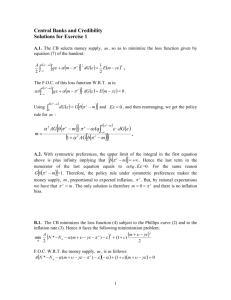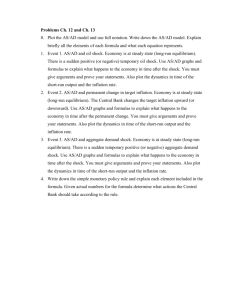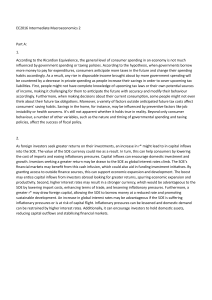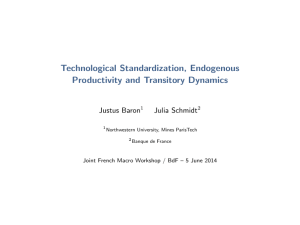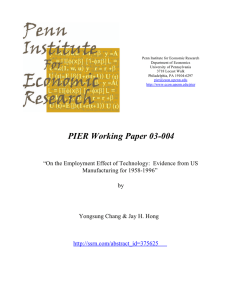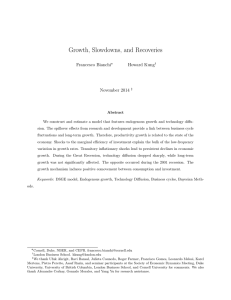SOLUTIONS
advertisement
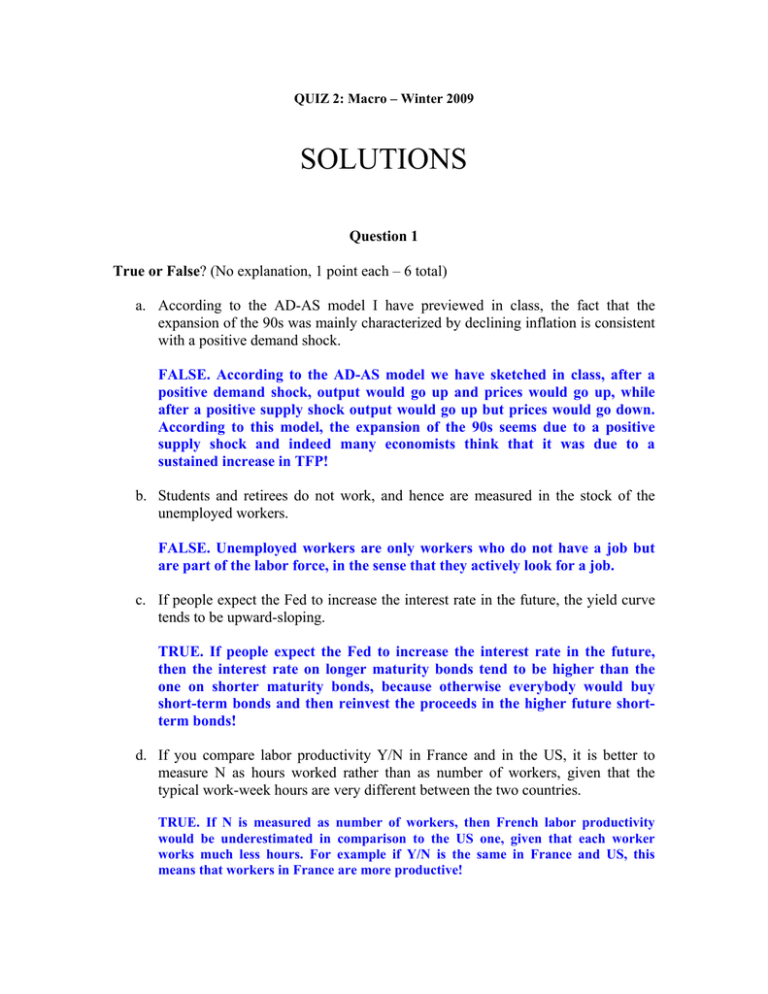
QUIZ 2: Macro – Winter 2009 SOLUTIONS Question 1 True or False? (No explanation, 1 point each – 6 total) a. According to the AD-AS model I have previewed in class, the fact that the expansion of the 90s was mainly characterized by declining inflation is consistent with a positive demand shock. FALSE. According to the AD-AS model we have sketched in class, after a positive demand shock, output would go up and prices would go up, while after a positive supply shock output would go up but prices would go down. According to this model, the expansion of the 90s seems due to a positive supply shock and indeed many economists think that it was due to a sustained increase in TFP! b. Students and retirees do not work, and hence are measured in the stock of the unemployed workers. FALSE. Unemployed workers are only workers who do not have a job but are part of the labor force, in the sense that they actively look for a job. c. If people expect the Fed to increase the interest rate in the future, the yield curve tends to be upward-sloping. TRUE. If people expect the Fed to increase the interest rate in the future, then the interest rate on longer maturity bonds tend to be higher than the one on shorter maturity bonds, because otherwise everybody would buy short-term bonds and then reinvest the proceeds in the higher future shortterm bonds! d. If you compare labor productivity Y/N in France and in the US, it is better to measure N as hours worked rather than as number of workers, given that the typical work-week hours are very different between the two countries. TRUE. If N is measured as number of workers, then French labor productivity would be underestimated in comparison to the US one, given that each worker works much less hours. For example if Y/N is the same in France and US, this means that workers in France are more productive! e. If there are diminishing returns to capital, as the capital stock increases an additional unit of capital increases output by a smaller amount. TRUE. This is the definition of diminishing returns to capital. f. TFP growth rate cannot be measured even if we assume that the production function is Cobb-Douglas. FALSE. As we have seen in class, if we assume that the production function is Cobb-Douglas, then we can measure TFP growth rate as a residual! Question 2 Imagine in Country X, the data on GDP (Y), capital (K) and labor (N) in 2007 and 2008 are the following: Year Y K N 2007 2008 2000 2100 250 300 1250 1200 Assume that the production function of Country X can be well approximated by the Cobb-Douglas form: Y = AK0.3N0.7 . Hence, the growth accounting equation is the same we have seen in class: ΔY/Y = ΔA/A + .3 ΔK/K + .7 ΔN/N a. What is the growth rate of TFP (A) between 2007 and 2008? --- 4 points First, you can calculate the growth rate of K, N, and Y: ΔY/Y = (Y(2008)-Y(2007))/Y(2007) = 0.05 ΔK/K = (K(2008)-K(2007))/K(2007) = 0.2 ΔN/N = (N(2008)-N(2007))/N(2007) = -0.04 Using the growth accounting equation above, we then can calculate the growth rate of A: ΔA/A = ΔY/Y - .3 ΔK/K - .7 ΔN/N = 0.018 1.8% b. What is the growth rate of labor productivity (Y/N) between year 2000 and 2008? --- 4 points. Here you could answer both using the approximated formula or using the exact formula. With the approximated formula, the growth rate of labor productivity is equal to: ΔY/Y - ΔN/N = 0.09 With the exact formula Y/N(2007) = 1.6 Y/N(2008) = 1.75 Then Δ(Y/N)/(Y/N) = (1.75 – 1.6)/1.6 = 0.09 9% Question 3 Recent data show that inflation in December 2008 reached 0.7%, one of the lowest level since 1954! This big drop was unexpected and was much below any measure of expected inflation. Suppose expected inflation at the end of 2007 was 2.7%. Suppose that at the end of 2007 Mary borrowed $100,000 at the yearly nominal interest rate of 6.7%. What was her expected real interest rate when she decided how much to borrow? What was the realized real interest rate she had to pay at the end of 2008? Did she gain or lose in comparison to her expectations? --- 4 points When Mary decided to borrow, her expected real interest rate was re = i - πe = 6.7% - 2.7% = 4%. When instead at the end of 2008 the realized inflation turned out to be 0.7%, then the effective real interest rate she had to pay was ra = i - πa = 6.7% - 0.7% = 6%. Hence, she had to pay higher real interest rate than what she expected, losing money in comparison to her expectations. Question 4: In the Economist article entitled “To these, the spoils”, the journalist reports “a new study by Stephen King, chief economist at the HSBC bank, concludes that workers and consumers have received the lion's share of the productivity gains of the revolution in information technology (IT)”. The journalist reports that in 1997-2000 despite a surge in productivity, non-financial firms profits decreased. Why is that? Report one of the reason explained in the article. (Your answer should not be more than a 10 words!)--- 4 points You get full credit if you report any of the following: 1) There was a fall in the IT goods that consumers bought 2) The IT spurred competition across firms, squeezing prices and profits 3) Globalization has reduced the pricing power of the firms even further




